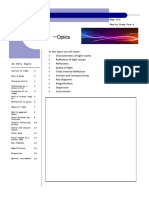0% found this document useful (0 votes)
3 views1 pageLight Reflection and Refraction Notes
Light is a form of energy that travels in straight lines and can move through a vacuum at a speed of 3 × 10^8 m/s. Reflection occurs when light bounces off surfaces, and there are two laws governing this phenomenon: the angle of incidence equals the angle of reflection, and all rays lie in the same plane. Images can be real or virtual, with plane mirrors producing virtual, erect images that are the same size as the object and laterally inverted.
Uploaded by
aswinasking123Copyright
© © All Rights Reserved
We take content rights seriously. If you suspect this is your content, claim it here.
Available Formats
Download as PDF, TXT or read online on Scribd
0% found this document useful (0 votes)
3 views1 pageLight Reflection and Refraction Notes
Light is a form of energy that travels in straight lines and can move through a vacuum at a speed of 3 × 10^8 m/s. Reflection occurs when light bounces off surfaces, and there are two laws governing this phenomenon: the angle of incidence equals the angle of reflection, and all rays lie in the same plane. Images can be real or virtual, with plane mirrors producing virtual, erect images that are the same size as the object and laterally inverted.
Uploaded by
aswinasking123Copyright
© © All Rights Reserved
We take content rights seriously. If you suspect this is your content, claim it here.
Available Formats
Download as PDF, TXT or read online on Scribd
/ 1


























































